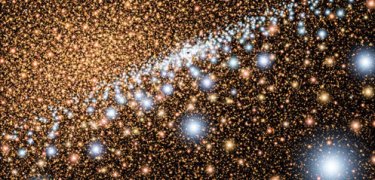
Star formation is a steady process, requiring vast clouds of cold gas to gradually accumulate and compact. So in the region around the supermassive black hole at the centre of our galaxy, which is awash with violent gravitational “tidal” forces, one would expect stars to be few and far between.
Over the years, however, many stars have been spotted near the galactic centre — which raises the question: were the stars able to survive a perilous birth, or did they somehow migrate inwards from elsewhere?
Now, a group of astronomers from the Harvard–Smithsonian Center for Astrophysics, US, and the Max Planck Institute for Radio Astronomy, Germany, has evidence that stars can indeed be born near the galactic centre. Using the Very Large Array of radio telescopes in New Mexico, they have discovered two baby stars, or “protostars”, just a few light-years from the Milky Way’s black hole.
It solves what has been a hotly debated mystery for astrophysicists Elizabeth Humphreys, Harvard–Smithsonian Center for Astrophysics
“It solves what has been a hotly debated mystery for astrophysicists,” Elizabeth Humphreys of the Harvard–Smithsonian centre told physicsworld.com. “Observing stars where they shouldn’t have been able to form has meant that exotic theories have been proposed, in which massive clusters of stars form much farther away from the black hole and then migrate inwards to the galactic centre before breaking apart into individual stars.”
Seeing through the dust
A protostar marks the embryonic stage in a star’s formation, before it has begun nuclear fusion and while it is still hidden within a collapsing cloud of dust and gas. This cloud absorbs visible light, so to see protostars astronomers have to search within infrared and radio wavelengths, such as those monitored by the Very Large Array. They normally appear as “water masers”, which result from the cloud — like a laboratory laser or maser — amplifying radio waves to the extent that they become beacons for detection on Earth.
The findings, which Humphreys presented at a meeting of the American Astronomical Society in Long Beach, California, earlier this week, were of two masers seven and ten light-years away from the Milky Way’s central black hole. Although they are not the first protostars close to a galactic centre to be discovered — one was detected by Karl Menten, also of the Max Planck Institute for Radio Astronomy, in 1997 — they do prove that star formation in such regions is no fluke.
Perhaps more interesting of one of the newly discovered protostars, however, is that it lies is a ring of material orbiting the central black hole known as a circumnuclear disk. This protostar would therefore seem to support some recent simulations of cloud collisions, which implies that star formation in these disks is theoretically possible. “[As] the theoretical models are getting closer to reality, that is to say including gas cloud collisions that might well happen in the chaotic region near the black hole, the stars can form where they are observed,” says Humphreys.
Too few stars
One theorist who has successfully modelled star formation in the circumnuclear disk is Sergei Nayakshin of the University of Leicester, UK. He agrees that the observations of Humphreys and colleagues support the simulations, but thinks that they also raise new questions. “The result from simulations is that you get many tens or hundreds of protostars at once, so I would have expected us to have seen a lot more of them,” he explains. “If they are there, I think they would have been discovered by now.”
What’s interesting is that the stars must be formed in a slightly different way to what we were thinking about, and this might shed new light on star formation theories Sergei Nayakshin, University of Leicester
Nayakshin suggests that there may be unknown physics at work that reduces the clumping of gas and dust in the Milky Way’s inner regions. If this were accounted for in the models it might become apparent that the stars are formed individually and not in groups. “What’s interesting is that the stars must be formed in a slightly different way to what we were thinking about, and this might shed new light on star formation theories,” he says.
Nevertheless, the fact that stars close to the galactic centre can form in situ does not diminish the possibility that many of the older observed stars migrated inwards from elsewhere in the galaxy. “In principle, this process could have operated in earlier days of the Galaxy, and might work in other galactic centres as well,” adds Nayakshin.



